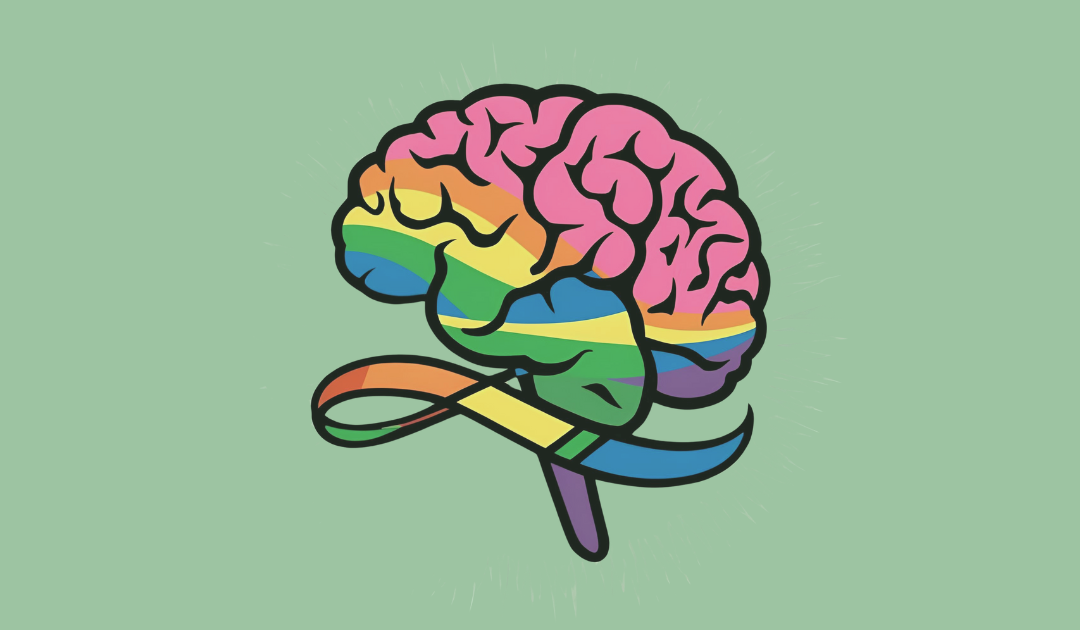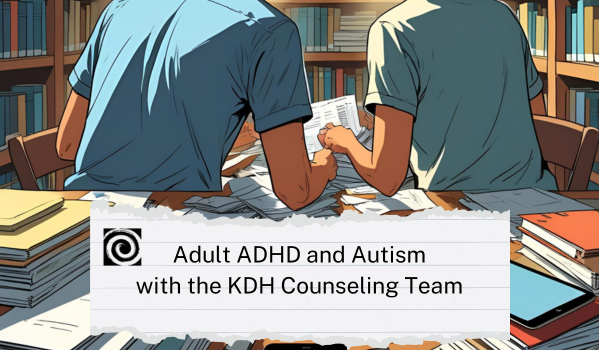Neurodiversity-Affirming Care with KDH Counseling
At KDH Counseling, our therapists specialize in a number of different areas, one of which being their ability to provide neurodiversity-affirming care
5 min read
KDH Counseling Team : Jul 25, 2025 12:48:17 PM

There’s a quiet knowing some people carry—a long-held sense that they’ve always moved through the world a little differently. Not wrongly, just… not quite like everyone else. Maybe they’ve always felt like they were watching life through a pane of glass, close enough to observe but never quite part of the scene. Maybe they’ve been told they’re too much—or not enough. Too sensitive. Too blunt. Too intense. Too quiet. Too literal. Too rigid. Too lost in their thoughts.
And then one day, often after years of masking, adapting, and wondering, that quiet knowing finds a name.
Autism.
Not in childhood. Not through school services or early interventions. But in adulthood—after a winding journey through misdiagnoses, self-doubt, and invisible labor.
For many adults, the process of receiving an autism diagnosis through psychological evaluation is nothing short of life-altering. It’s not just a clinical process—it’s a reintroduction to the self. A chance to say, “Oh. There was never anything wrong with me. I just didn’t have the right language.”
This blog is for those who are considering, navigating, or reflecting on the experience of being evaluated for autism in adulthood. It’s also for the clinicians who hold this process with reverence and care.
Adults seek autism evaluations for many reasons. Some are prompted by a child’s diagnosis and recognize overlapping traits in themselves. Others stumble into the possibility through social media, neurodivergent content, or an offhand comment that hits a little too close to home. Some have carried this question for years, quietly Googling in private, afraid of being dismissed—again.
And others have been misdiagnosed for decades. With depression, anxiety, obsessive-compulsive disorder, borderline personality disorder, bipolar, etc. It's not because those diagnoses are inaccurate (sometimes they’re part of the picture), but because autism in adults has historically been overlooked. This is especially true for women, people with marginalized orientations and identities, and those who are able to mask or camouflage well.
A psychological evaluation can offer clarity. It can validate lived experience. It can open the door to accommodations, self-advocacy, and more authentic self-expression. Most importantly, it can replace years of internalized shame with understanding.
A comprehensive autism evaluation for adults is nuanced, collaborative, and both lgbtqia- and trauma-informed. It seeks to understand the full breadth of a person’s developmental history, sensory and communication profile, social cognition, coping strategies, and life patterns.
Here’s what the process often includes:
We begin with a conversation—not just about symptoms, but about life.
In adulthood, we explore things like burnout cycles, masking behaviors, relationship patterns, rigid routines, sensory overload, communication preferences, and emotional regulation.
This is often one of the first times clients feel truly heard in their full complexity. It’s a space for story, not just checkboxes.
If possible, we may also gather collateral information from a parent, sibling, or childhood friend to help fill in early developmental details. But for many adults, especially those estranged from family or with late-realized identities, that’s not feasible. That’s okay. We work with what’s available.
Psychological evaluations often include standardized tools like:
Autism Diagnostic Observation Schedule–Second Edition (ADOS-2): Considered a gold standard, this semi-structured interaction assesses communication, social reciprocity, imagination, and behavioral patterns.
Autism Spectrum Quotient (AQ), RAADS-R, or SRS-2: Self-report measures exploring traits consistent with autism in adults. These will be more of the check-box type assessments that people might be familiar with from interactions with non-psychologist mental health clinicians and/or primary care physicians. These measures explore autistic characteristics and tendency at masking/camouflaging that may be preventing other professionals from identifying autism at an earlier point in the client's life.
Cognitive assessments: to assess working memory, processing speed, and executive functioning. This is likely to include assessments like the Weschler Adult Intelligence Scale (WAIS-5), which gives an overview of cognitive strengths and deficits based on comparing a person's results to what is considered to be "typical" for their age, gender, race/ethnicity, etc. While intelligence is right there in the title, the WAIS-5 is giving the psychologist a snapshot of a person's thinking and processing experiences, and not a wholistic view of what we consider true intelligence to be. The results of this type of assessment provide one piece of a very varied exploration of someone's internal and external functioning.
Executive functioning, adaptive behavior, and sensory profile measures as needed. There are a multitude of other ways we can assess for autism-adjacent traits and characteristics that may aid in clarifying diagnosis, depending on the specific presentation and needs of the client.
These tools don’t tell the whole story—but they give helpful data points. The most important part is how these findings align with a person’s narrative, values, and functioning across time and settings.
Many adults who present for autism evaluations have also been diagnosed with (or are exploring possible diagnoses of):
Generalized Anxiety Disorder or Social Anxiety
Depression
Borderline personality disorder (BPD) or other personality disorders
The evaluation process includes careful attention to differential diagnosis. Some traits can overlap—executive dysfunction, rigidity, emotional dysregulation, or sensory issues can look different depending on context.
Rather than a binary approach, the best evaluations recognize the intersectionality of neurodivergent identities. Many autistic adults are also ADHDers. Many have trauma. Many have adapted in brilliant and exhausting ways.
A skilled clinician doesn’t strip this complexity away—they hold it with nuance and precision.
After gathering data and synthesizing findings, the clinician meets with the client for a feedback session. This is where everything comes together—not just scores, but meaning.
Here, we talk through the diagnostic impressions. Sometimes that includes a formal autism diagnosis. Sometimes it affirms traits consistent with autism but not meeting full criteria. And sometimes, the findings point to something adjacent, such as complex trauma or sensory processing differences.
But no matter the outcome, the goal is always clarity, compassion, and empowerment.
Clients often leave this session with a mix of relief, grief, validation, and recognition. That quiet knowing finally has words. And often, that changes everything.
The reason so many adults—especially women, queer folks, and BIPOC individuals—go undiagnosed is because autism has long been defined through a narrow, male-centered, childhood lens. Adults may not “look autistic” in the stereotypical sense, but present with:
Chronic social fatigue or masking exhaustion
Persistent feelings of being different or “not quite human”
Hyper-awareness of social rules without intuitive understanding
Strong preference for routine or sameness
Sensory sensitivities or sensory-seeking behaviors
Difficulty initiating or transitioning tasks
Special interests or deep knowledge pursuits
Burnout cycles that mimic depression
Literal thinking or difficulty with sarcasm/nuance
Struggles with unstructured time, ambiguity, or vague expectations
History of being misread, misdiagnosed, or misunderstood
Recognizing these patterns retroactively can feel like putting on corrective lenses after a lifetime of blurry vision.
An adult autism diagnosis is not a cure, nor a sudden transformation. But it is often a reckoning—a recalibration of self-perception. It invites people to stop pathologizing their pain and start contextualizing it. To stop asking, “What’s wrong with me?” and start asking, “What supports do I need?”
It matters because it allows:
Access to accommodations in work, school, or healthcare
Tailored therapeutic approaches (e.g., autism-affirming therapy, DBT with sensory considerations)
Language to describe and advocate for needs
Reframing of past experiences through a new, more compassionate lens
Community and belonging in neurodivergent spaces
And for some, it offers something even more profound: the invitation to unmask, slowly and safely, and begin living with more authenticity.
You are not late. Autism was there all along, waiting to be named.
A diagnosis is not about limits—it’s about understanding.
Grief is normal. So is joy.
Your experience is valid, even if others miss it.
You deserve care that sees your whole self—not just your symptoms.
For many adults, receiving an autism diagnosis is not the beginning of a new story—it’s the moment the old one finally makes sense. It’s the first chapter written in a language they can read. And more than anything, it’s an act of coming home.
If you are exploring the possibility of autism, know this: you are not broken. You are beautifully, intricately, unmistakably human. And you deserve to understand the way your mind works—not so you can fix it, but so you can care for it.
With the right support, evaluation can be a turning point—not toward conformity, but toward liberation.

At KDH Counseling, our therapists specialize in a number of different areas, one of which being their ability to provide neurodiversity-affirming care

In recent years, more adults are seeking answers to questions they’ve carried with them for decades, even if they only recently found the language...

Attention-Deficit/Hyperactivity Disorder (ADHD) is often mischaracterized—reduced to images of fidgety schoolchildren or distracted professionals...